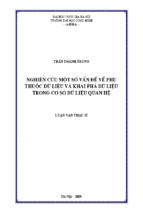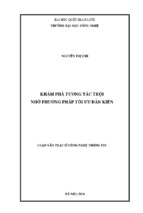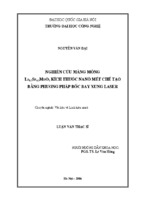VIETNAM NATIONAL UNIVERSITY HANOI
COLLEGE OF TECHNOLOGY
Nguyen Duc Dung
HIGH YIELD SYNTHESIS OF MULTI-WALLED
CARBON NANOTUBES FROM CaCO3 SUPPORTED
IRON (III) NITRATE CATALYST
MASTER THESIS
Hanoi - 2006
VIETNAM NATIONAL UNIVERSITY HANOI
COLLEGE OF TECHNOLOGY
Nguyen Duc Dung
HIGH YIELD SYNTHESIS OF MULTI-WALLED
CARBON NANOTUBES FROM CaCO3 SUPPORTED
IRON (III) NITRATE CATALYST
Speciality: Nano Materials and Devices
MASTER THESIS
Advisor: Dr. Phan Ngoc Minh
Hanoi - 2006
Content
Abbreviations
3
Preface and target of the work
4
Chapter 1. Introduction to carbon nanotubes material
7
1.1. Brief history of carbon canotubes
7
1.2. Geometry of carbon nanotubes
8
1.3. Syntheses of carbon canotubes
13
1.3.1. Arc discharge
13
1.3.2. Laser ablation
14
1.3.3. Chemical vapor deposition
15
1.4. Growth mechanism of carbon nanotubes
19
1.5. Purification
20
1.5.1. Oxidization
21
1.5.2. Acid treatment
21
1.5.3. Micro filtration
21
1.6. Physical properties
22
1.6.1. Electronic properties
22
1.6.2. Mechanical properties
25
1.7. Application of carbon nanotubes
27
1.7.1. Energy storage
27
1.7.2. Composite materials
29
Chapter 2. Experimental and investigation methods
31
2.1. Experimental
31
2.1.1. Description of the CVD system for growing carbon nanotubes
31
2.1.2 Synthesis of carbon nanotubes
31
2.2. Investigation methods
35
2.2.1. Electron microscope
35
1
2.2.2. Raman spectroscopy of carbon nanotubes
38
2.2.3. Xray diffraction of carbon nanotubes
41
2.2.4. Thermogravimetric analysis
42
Chapter 3. Results and discussion
43
3.1. Catalytic Fe nanoparticles in the CNTs growth process
43
3.1.1. Effect of supported iron salts on the CVD products
43
3.1.2. Formation of catalytic Fe nanoparticles nucleating CNTs
47
3.2. Effect of growth temperature
53
3.2.1. CNTs perfomance
53
3.2.2. Structural characteristics of CNTs
54
3.3. Optimal procedure for large-scale synthesis of MWCNTs
59
Conclusion
62
References
63
2
Abbreviations
CCVD
Catalytic Chemical Vapor Deposition
CFs
Carbon Fibers
CNTs
Carbon Nanotubes
CVD
Chemical Vapor Deposition
DrTGA
Differential Thermo-Gravimetric Ananlysis
ECDL
Electro-Chemical Double Layer
EDX
Energy Dispersive X-ray spectroscopy
FTIR
Fourier Transform Infrared
HRTEM
High Resolution Transmission Electron microscope
MWCNTs
Multi-Walled Carbon Nanotubes
PECVD
Plasma Enhanced Chemical Vapor Deposition
SCCM
Standard Cubic Centimeters per Minute
SEM
Scanning Electron Microscope
STEM
Scanning Transmission Electron Microscope
STM
Scanning Tunneling Microscope
SWCNTs
Single-Walled Carbon Nanotubes
TEM
Transmission Electron microscope
TGA
Thermo-Gravimetric Analysis
XRD
X-Ray Diffraction
3
Preface and target of the work
Carbon nanotubes were identified for the first time in 1991 by Sumio Iijima at
the NEC Research Laboratory. By using high resolution transmission electron
microscope (HRTEM) he clearly observed the tiny tubes called multi-walled carbon
nanotubes (MWCNTs) in the soot made from by-product obtained in the synthesis
of fullerenes. The MWCNTs comprise carbon atoms arranged in a graphitic
structure rolled up to form concentric cylinders [38]. Two years later, single-walled
carbon nanotubes (SWCNTs) were synthesized by adding metal particles to the
carbon electrodes [9, 36].
Their small diameter (of the order of a nanometer) and their long length (of the
order of microns) lead to aspect ratios so large that the carbon nanotubes possibly
reach to ideal one-dimensional (1D) systems. Depending on the chirality of their
atomic structure, they can be excellent metals or semiconductors with a band gap
that is inversely proportional to their diameter. Theoretical and experimental results
have shown extremely high elastic modulus, greater than 1 TPa and strengths 10100 times higher than strongest steel [77]. In addition to exceptional mechanical
properties, they also possess superior thermal properties: thermally stable up to
2800oC in vacuum, thermal conductivity about twice as high as diamond [16]. The
above properties make carbon nanotubes (CNTs) the object of widespread studies in
both basic science and technology. They can be applied in many fields: fabrication
of nano sized electronic devices, energy storage equipments, field emission display,
nano probes, nano composites,...
There are many methods (mentioned in detail in section 1.3) for synthesizing
carbon nanotubes having different performance from diverse material sources. The
arc discharge method relates to connecting two graphite rods to a power supply,
placing them millimeters apart, and vaporizing carbon by a hot plasma. Its product
can be SWCNTs and MWCNTs with few structural defects. Tubes tend to be short
with random sizes and directions. This method can produce large scale production
4
of CNTs but its typical yield of about 30% is not high. Laser ablation method was
firstly used in 1996 by Smalley at al. using intense laser pulses blasting graphite to
form primarily SWCNTs. The diameters of SWCNTs can be controlled in a large
range by varying the reaction temperature. Although the yield of laser ablation
method can reach to 70%, it has never been candidate for large-scale production
because of requiring expensive lasers and the limitation of a laser spot area.
Emerging as the best method for industrial production of CNTs is chemical vapor
deposition (CVD). Carbon feedstocks are hydrocarbons in gaseous and liquid
phases, alcohol, etc., decomposed at 600-1200oC into carbon atoms recombining to
nanotubes over metal nanoparticles. Carbon nanotubes produced by CVD having
the yield probably up to 100% are usually long MWCNTs with quite high defects.
Thus, the investigation of suitable technologies to synthesize large-scale production
of carbon nanotubes with high yield and purity to reduce cost satisfying for
industrial demands is an opening solution until now.
The most common and optimal method for large-scale production of CNTs is
catalytic chemical vapor deposition (CCVD) (discussed in section 1.3.3). In the
CCVD process, catalyst supports are the essential ingredients such as, MgO, Al2O3,
SiO2, CaCO3 etc., due to their high surface area for CCVD reaction. The choice of
CaCO3 as catalyst support was reported in Ref. [18]. The advantages of this
technique are:
CaCO3 support is easily dissolved in a dilute acid, thus the CNTs
purification is a one-step procedure, simple and harmless to CNTs structure.
CaCO3 and Fe salts from which catalysts synthesized are available in
market and low cost.
This is the simplest CVD method for large scale production of CNTs.
By supplying catalysts and collecting CVD product continuously, the production
yield is significantly increased.
With the aim of large scale and low cost production and the idea using CaCO3
support, this thesis investigates the technological aspects that relate to synthesis of
5
carbon nanotubes. We develop a simple method for making catalyst only by
grinding CaCO3 and Fe salts, therefore, neglect the impregnating and drying steps,
that reduce stages in CNTs synthesis. The addition of H2 gas in CVD process is
believed not only to form Fe nanoparticles enhancing catalytic activity but also to
improve the CNTs yield. By varying growth temperature, another role of CaCO3 as
the factor contributing to the formation of Fe nanoparticles necessary to the CNTs
growth is studied in this thesis. Furthermore, Fe salt radicals are found significant to
the creation of Fe nanoparticles on the support (CaCO3 or CaO). At last, the more
dilute acid (HCl 10%) is used for purification process.
The arrangement of the thesis:
In addition to the “Preface and target of the work” and “Conclusion” parts the
thesis is organized into three chapters as follow:
Chapter 1 shows an overview of carbon nanotubes material, the CNTs
synthesizing methods and ability in industrial applications.
Chapter 2 lists the experimental process for synthesis of carbon nanotubes.
This chapter also introduces investigation methods mainly used during this thesis.
Chapter 3 indicates the effect of Fe content in catalysts. The formation of Fe
nanoparticles necessary to CNTs growth is studied. The structural characteristics of
the CNTs depend on the growth temperature are characterized. The optimal
chemical vapor deposition process is established for the aim of large-scale
production of carbon nanotubes. It is confirmed that by using the presented
technique we can produce 97.9 % purity, 78.6 % yield CNTs with mass of 50
grams/day.
6
Chapter 1. Introduction to carbon nanotubes material
1.1. Brief history of carbon nanotubes
In 1970‟s and 1980‟s, small diameter carbon filaments were produced through
the synthesis of carbon fibers by the decomposition of hydrocarbons at high
temperature in the presence of transition metal catalyst nanoparticles [57, 78].
However, there was not any detailed systematic study on such small filaments until
the observation of carbon nanotubes by Iijima in 1991 [38]. These tubes (called
multiwall carbon nanotubes) contained at least two layers, often many more, and
ranged in outer diameter from about 3 nm to 30 nm with both closed ends.
A new class of carbon nanotubes with only single layer was discovered in
1993 [9, 36]. These single-walled nanotubes with diameters typically in the range 12 nm are generally narrower than the multiwalled nanotubes, and tend to be curved
rather than straight. Since these pioneering works, the study of carbon nanotubes
has developed rapidly.
Fig 1.1: Multi-walled CNTs observed in 1991 [38].
7
1.2. Geometry of carbon nanotubes
The structure of carbon nanotubes has been characterized by High Resolution
Transmission Electron Microscope (HRTEM) and Scanning Tunneling Microscope
(STM). These techniques directly confirmed that the carbon nanotubes are cylinders
derived from the honeycomb lattice representing a single atomic layer of crystalline
graphite (a graphen sheet). Most important structures are single walled carbon
nanotubes (SWCNTs) and multiwalled carbon nanotubes (MWCNTs). A SWCNT
is considered as a cylinder with only one wrapped graphene sheet. Multi walled
carbon nanotubes (MWCNTs) are similar to a set of concentric SWNTs. The
structure of a single walled carbon nanotube is explained in terms of its 1D unit
cell, defined by the vectors Ch and T in Fig. 1.2a [20].
The circumference of any carbon nanotube is expressed in terms of the chiral
vector Ch = nâ1 + mâ2 which connects two crystallographically equivalent sites on a
2D graphene sheet (see Fig. 1.2a). The construction in Fig. 1.2a depends uniquely
on the pair of integers (n, m) which specify the chiral vector. Fig. 1.2a shows the
chiral angle θ between the chiral vector and the “zigzag” direction (θ = 0) and the
unit vectors â1 and â2 of the hexagonal honeycomb lattice of the graphene sheet.
Three distinct types of carbon nanotube structures can be generated by rolling up
the graphene sheet into a cylinder as discribe below and shown in Fig. 1.3. The
zigzag and armchair nanotubes, respectively, correspond to chiral angles of θ = 0
and 30o, and chiral nanotubes correspond to 0 < θ < 30o. The intersection of the
vector OB (which is normal to Ch) with the first lattice point determines the
fundamental one dimension (1D) translation vector T. The unit cell of the 1D lattice
is the rectangle defined by the vectors Ch and T (Fig. 1.2a).
8
(a)
(b)
Fig 1.2: (a) The chiral vector OA or Ch = nâ1 + mâ2 is defined on the honeycomb
lattice of carbon atoms by unit vector â1 and â2 and the chiral angle θ with
respect to the zigzag axis. Along the zigzag axis θ = 0o. Also shown are the
lattice vector OB = T of the 1D nanotube unit cell and the rotation angle ψ
and the translation τ which constitute the basic symmetry operation R = ( ψ/τ)
for the carbon nanotube. The diagram is constructed for (n, m) = (4, 2). (b)
Possible vectors specified by the pair of integers (n, m) for general carbon
nanotubes, including zigzag, armchair, and chiral nanotubes. Below each pair
of integers (n, m) is listed the number of distinct caps that can be joined
continuously to the carbon nanotube denoted by (n, m). The encircled dots
denote metallic nanotubes while the small dots are for semiconducting
nanotubes.
9
Fig. 1.3: Schematic models for single-wall carbon nanotubes with the nanotube axis
normal to the chiral vector which, inturn, is along: (a) the θ = 30o direction
[an armchair (n, n) nanotube], (b) the θ = 0o direction [a zigzag (n, 0)
nanotube] and (c) a general θ direction with 0 < θ < 30o [a chiral (n, m)
nanotube]. The actual nanotubes shown here correspond to (n, m) values of :
(a) (5, 5), (b) (9, 0), and (c) (10, 5).
The cylinder connecting the two hemispherical caps of the carbon nanotube
(see Fig. 1.3) is formed by superimposing the two ends of the vector Ch and the
cylinder joint is made along the two lines OB and AB ' in Fig. 1.2a. The lines OB
and AB ' are both perpendicular to the vector Ch at each end of Ch. In the (n, m)
notation for Ch = nâ1 + mâ2, the vectors (n, 0) or (0, m) denote zigzag nanotubes
and the vectors (n, n) denote armchair nanotubes. All other vectors (n, m)
correspond to chiral nanotubes. The nanotube diameter dt is given by
dt 3aC C (m2 ma m2 )1/ 2 / Ch /
(1.1)
where Ch is the length of Ch, aC-C is the C – C bond length (1.42 Å). The chiral
angle θ is given by
10
tan 1 3n / 2m n
(1.2)
From (1.2) it follows that θ = 30o for the (n, n) armchair nanotube and that the (n, 0)
zigzag nanotube would have θ =60o. From Fig. 1.2a it follows that if we limit θ to
be between 0 < θ < 30o, then by symmetry θ = 0 for a zigzag nanotube. Both
armchair and zigzag nanotubes have a mirror plane and thus are considered as
achiral. Differences in the nanotube diameter dt and chiral angle θ give rise to
differences in the properties of various carbon nanotubes. The symmetry vector R =
(ψ/τ) of the symmetry group for the nanotubes is indicated in Fig. 1.2a, where both
the translation unit or pitch τ and the rotation angle ψ are shown. The number of
hexagons, N, per unit cell of a chiral nanotube, specified by integers (n, m) is given
by
N = 2(m2 + mn + n2)/dR
(1.3)
where dR = d if n – m is not a multiple of 3d or dR = 3d, if n – m is a multiple of 3d
and d is defined as the largest common divisor of (n, m). Each hexagon in the
honeycomb lattice (Fig. 1.2a) contains two carbon atoms. The unit cell area of the
carbon nanotube is N times larger than that for a graphen layer and consequently the
unit cell area for the nanotube in reciprocal space is corresponding 1/N times
smaller. Table 1.1 [21] provides a summary of relation useful for describing the
structure of single wall nanotubes. Fig. 1.2b indicates the nanotubes that are
semiconducting and those that are metallic, and shows the number of distinct
fullerene caps that can be used to close the end of an (n, m) nanotube, such that the
fullerene cap satisfies the isolated pentagon rule.
11
Table 1.1 Structural parameters for carbon nanotubes
Symbol
Name
aC-C
C – C distance
a
Length of unit vector
a1, a2
Unit vectors
b1, b2
Reciprocal
vectors
lattice
Chiral vector
Length of Ch
dt
Diameter
θ
Chiral angle
d
dR
Gcd (n, m)b)
Gcd (2n + m, 2m +n)b)
Translational vector
T
Length of T
N
Number of hexagons
in the nanotube cell
R
Symmetry vector
τ
Pitch of R
ψ
Rotation angle of R
M
Number of T in N.R
Value
1.421 Å
2.456 Å
3a CC
a1
Ch
L
T
Formula
a 3
a 3
, a2
2 1
2 1
1
1
2π
2π
b1
3 , b2 3
a
a
1
1
Ch = n.a1 + m.a2
x, y
coordinate
x, y
coordinate
(0 ≤ |n| ≤ m)
L 3a CC (n 2 nm m 2 )
dt
L
π
Ch .a1
2n m
cos
Ch . a1 2 n 2 nm m 2
dR
3d if (nm) 3
d if (nm) 3
T t 1 .t 1 t 2 .t 2 ,
t1
2.n m
2.m n
, t2
dR
dR
T
3L
dR
N
2 ( n 2 nm m 2 )
dR
gcd(t1, t2) =
1b)
R = p.a1+q.a2,
gcd(p, q) =
t1.p - t2.q=1 (0 ≤ mp - nq ≤ N) 1b)
(mp nq)T
N
radians
2
N
N.R = M.Ch + M.T
12
a)
In this table n, m, t1, t2, p, q are integers and d, dR, N and M are integer
functions of these integers
b)
gcd (n, m) denotes the greatest common divisor of the two integers n and m.
1.3. Syntheses of carbon nanotubes
1.3.1. Arc discharge
The arc discharge was the first available method for the production of both
MWCNTs and SWCNTs. This technique has been in use for a long time for the
production of carbon fibers. It is a worthy note that carbon nanotubes were probably
observed before 1991 but not recognized.
In the arc-discharge technique, two graphite rods were used as the anode and
cathode, and placed inside a growth chamber filled with helium atmosphere. When
a high current is passed through the opposing graphite anode and cathode, helium
gas plasma evaporates carbon atoms in the anode, which deposits to form carbon
nanotubes on the cathode.
Fig. 1.4: An arc discharge apparatus produced the first CNTs [78].
13
To produce isolated SWCNT catalysts such as Co, Ni, Fe, Y are used. Mixed
catalysts such as Fe/Ni, Co/Ni and Co/Pt are used to grow bundles of SWNTs. For
the synthesis of MWCNTs no catalyst is necessary and with the use of halide
(potassium chloride) as a promoter in hydrogen atmosphere large scale production
would be expected [34]. The nanotubes are found in the inner region of the cathode
deposit and they are surrounded by a hard shell consisting of nanoparticles,
fullerenes and amorphous carbon [1, 37].
1.3.2. Laser ablation
An efficient route for synthesis of CNTs with a narrow diameter distribution is
a laser ablation of a graphite target. In the laser ablation technique, an intense laser
beam is utilized to vaporize a graphite target doped with metal catalysts in a tube
furnace at temperatures near 1200oC, while an inert gas jet passing through the
deposition chamber carries nanotubes onto a metal collector.
Fig. 1.5: Laser ablation system for growing CNTs [87].
14
In the early report [30], the laser beam scanned across the target surface under
computer control to maintain the smooth, uniform face for vaporization. The target
was supported by graphite poles in a 1 inch quartz tube evacuated to 10 mTorr and
then filled with 500 Torr argon flowing at 50 sccm. The flow tube was mounted in a
high temperature furnace with a maximum temperature of 1200 oC. The soot
produced by the laser vaporization was swept by the flowing Ar gas from the high
temperature zone, and deposit on a water-cooled copper collector positioned
downstream, just outside the furnace.
MWCNTs are produced if the target is made of pure graphite [33] but in case
of the target composed of graphite and metal [76] SWCNTs are synthesized.
1.3.3. Chemical vapor deposition (CVD)
Chemical vapor deposition (CVD) is a process whereby a solid material is
deposited from a vapor by a chemical reaction occurring on or in a surrounding area
of a normally heated substrate surface. The solid material is obtained as a coating, a
powder, or as single crystals. By varying the experimental conditions: substrate
material, substrate temperature, composition of the reaction gas mixture, total
pressure gas flows, etc., materials with different properties can be grown.
In the CVD synthesis of CNTs different hydrocarbons such as acetylene
(C2H2), methane (CH4), benzene (C6H6), etc. and also carbon monoxide (CO) are
decomposed over different metals (Fe, Co, Ni…) at temperatures between 400oC
and 1200°C. There are some other carbon allotropes except CNTs in a CVD product
such as fibers [31, 53], planar nano-graphenes [63], amorphous, etc. depending on
the CVD conditions. This is why technological research on synthesizing CNTs is
necessary beside basic research.
It can be classified CVD methods for synthesis of CNTs according to
techniques making catalyst as described below:
CVD method on flat substrates
For the CVD synthesis of CNTs on flat substrates, a quartz tube is often
15
horizontally placed in a thermal or electrical furnace. The substrate (e.g. silicon,
aluminium, graphite…) is coated with a metal catalyst. The metal catalyst on the
substrate is derived from coating metal oxalate, nitrate solution [39, 54] or
evaporating the metal film [91]. The substrate and the metal are then exposed to an
atmosphere containing a hydrocarbon gas and a carrier gas (Ar, N2) for a certain
time to grow CNTs.
An aided CVD method for flat substrates is plasma enhanced chemical vapor
depostion (PECVD). In the PECVD method, carbon nanotubes are also deposited
on a metal coated flat substrate but the substrate is located inside a plasma. Usually
one of the following plasmas is used: RF- (radio frequency), MW-(microwave) or a
DC-(direct current) plasma. Often a methane (CH4) and hydrogen (H2) gas mixture
with a ratio of 1% CH4 to 99% H2 is used at a total pressure between 1 and 40 mbar
and a temperature of 900 °C [43].
Fig. 1.6: Schematic diagram of PECVD system.
16
CVD method on catalytic substrates
Catalytic substrates are usually 3d metallic substrates such as Ni containing
alloy, stainless steel grid and plate, etc. Metallic substrate surface prior to CVD
reaction is important because of conditions for forming nanoparticles. The
oxidation-reduction treatment is oxidation of the metallic surface by airflow at
elevated temperatures and then by flow of hydrogen for reduction of the metal oxide
[81]. The other for treating the surface is introducing hydrogen flow in the whole
CVD process [32]. Oxidation in air can result in the fragment of the metallic surface
to form fine nanoparticle structures. The reduction by hydrogen is necessary for
forming metal nanoparticles enhancing catalytic activity. The two treatments also
create granular structures increasing the catalytic surface area. Most of CVD
products in cases using bulk metallic substrates were MWCNTs [32, 49, 71, 81].
Floating catalytic CVD
Floating catalytic CVD is a process where un-supported catalysts are formed
in situ by injecting volatile organometallic molecules, such as metallocenes or iron
pentacarbonyl, into a reactor with a carbon feedstock [2, 13]. The schematic
diagrams of two conventional apparatuses for floating catalyst method are shown in
Fig. 1.7 [74]. The carbon feedstock can be in liquid or gaseous phase. The furnace
has two heating zone, one with the sublimation temperature of precursor (90-110oC
for ferrocen), the other with temperature of CVD reaction (900-1100oC) [74]. The
precursor (ferrocen) vapor is carried into the reactor by argon flux that includes a
hydrocarbon flow (Fig. 1.7b) or the vapor of ethanol that is generated by bubbling
Ar gas via ethanol liquid (Fig. 1.7a).
This method allows a three-dimensional dispersion of carbon feedstock with
the catalytic particles so that the ability for continuous production of high purity
CNTs with low cost is preferable for industrial applications [13, 50].
17
(a)
(b)
Fig. 1.7: Schematic diagram of floating CVD system with (a) gaseous and (b) liquid
carbon feedstock.
Catalytic CVD (CCVD)
This is the most promising method for synthesis of large-scale CNTs with low
cost because of the ability to control the reaction parameters [52, 58]. By this
process, a variety of liquid, solid, or gaseous carbon sources are introduced into the
reaction zone over a catalyst at a controlled temperature [52, 58]. Most of catalysts
employed are related to Fe, Co, Ni and other transition metals (or combination of
them) dispersed on different supports such as SiO2, Al2O3, MgO or zeolites [11, 17,
52, 70]. For synthesizing these supported catalysts, the impregnant method is
usually used. Metal salts or mixture of metal salts are dissolved in distilled water,
ethanol or other suitable solvents to form solution which is then added the apposite
support amount and evaporated. Fig. 1.8 [41] shows a simple scheme for a CCVD
system. According to the scheme, a catalyst is sprayed on the quartz boat and is
placed in the furnace center. After a CCVD process, CNTs deposited on the quartz
boat are taken out.
18
- Xem thêm -




















